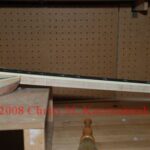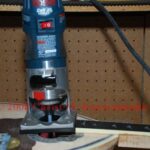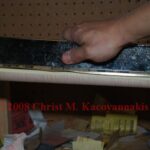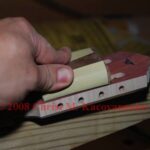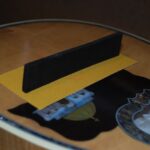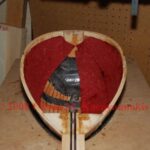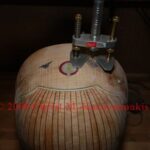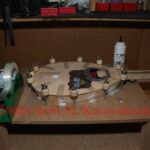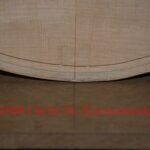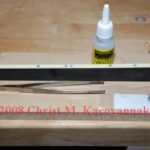The fretboard is glued to the neck with instrument maker’s glue, after the neck has been cut down so that it is slightly oversize. A board is placed over the fingerboard to spread the pressure from the clamps and to protect the wood from being marred by the clamp heads.
Shaping the neck
The neck is shaped to the players preferred shape. There are different widths of necks, as well as thicknesses and shapes. Some players prefer a very thick, beefy neck, while others prefer a very light, slim neck. First, the neck is trimmed flush with the fretboard with a router and flush cutting bit. The neck […]
Installing the Frets
Level the fretboard First, make sure the fretboard is flat after installation. Fretwire is then cut to length for each individual fret. Pressing the frets The frets are then pressed into the slots. Then the frets are trimmed flush with the end of the fretboard and filed smooth. The frets are leveled. Shaping the frets […]
Applying the Finish
Sanding the instrument in preparation for applying the finish Once the fret work is complete, the bouzouki can be finished. The quality of the finish achieved will only be as good as the quality of the preparation work. The entire instrument (minus the fretboard and frets) must first be sanded. Start with 100 grit paper, […]
Making the Bridge
Fitting the bridge blank to the soundboard curvature The bridge must be fitted to the curvature of the soundboard. Place a strip of adhesive backed sandpaper on the soundboard at the position of the bridge. Rub the bridge blank back and forth on the sandpaper until the bottom of the blank matches the curvature of […]
Lining the bowl
After the neck has been glued to the body, the body is lined with paper. The paper acts as reinforcement to the seems of the staves. Five pieces of paper are cut out and line the body, and then two more are cut out to line the tail block and head block. They are glued […]
Inlaying the body
The back and sides of the body can be inlaid with various designs. The inlays are usually placed on the wide capping strip, or on the side pieces, just above the capping strip. This process is the same as inlaying the soundboard. The inlays are cut from shell with a fine jeweler’s saw, and then […]
Attaching the soundboard to the body
The soundboard is glued to the body with instrument maker’s glue. The body is placed in a special fixture, which holds the body and instrument making clamps. Glue is applied to the kerfed lining and the top is held in place with the clamps and filament tape. After the glue dries, the excess soundboard wood […]
Installing the soundboard purfling and binding
The soundboard is surrounded with purfling and binding. On higher end bouzoukis, the purfling usually consists of multi-line black and white purfling surrounding abalone strips. The binding is then installed outside of that. Unlike guitars, which have the binding installed with the narrow edge up, the bouzouki’s binding is installed with the wide side up. […]
Making the fretboard
The fretboard is made of ebony. It is cut to length, but not tapered. The fret slots are cut into the fretboard first, and then the fretboard is tapered, and bound with binding to match the body. Then small dots are inlaid in the binding to mark the fret positions. They are glued in with […]
